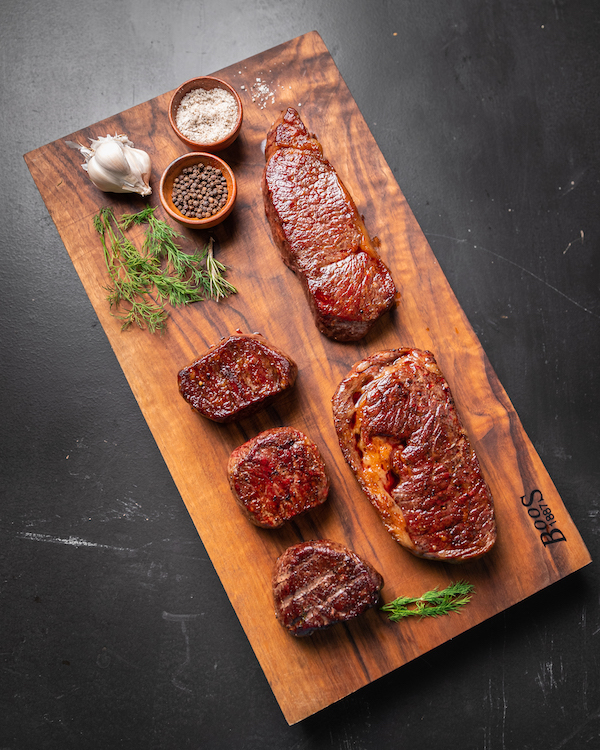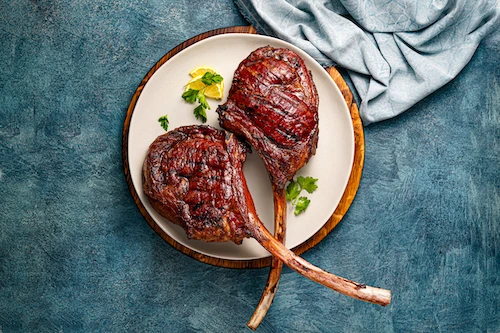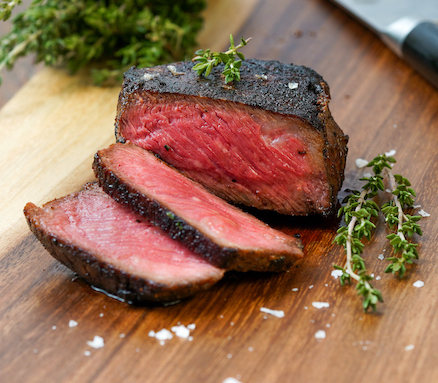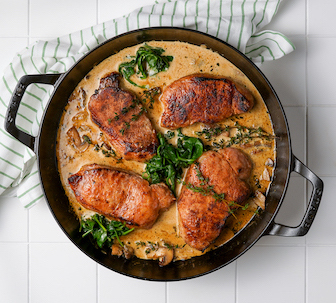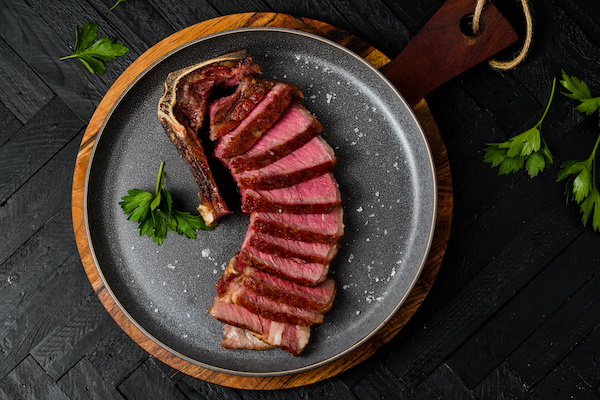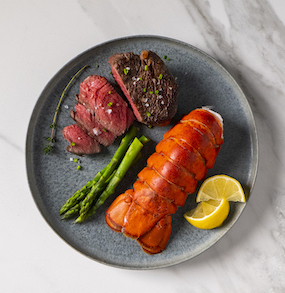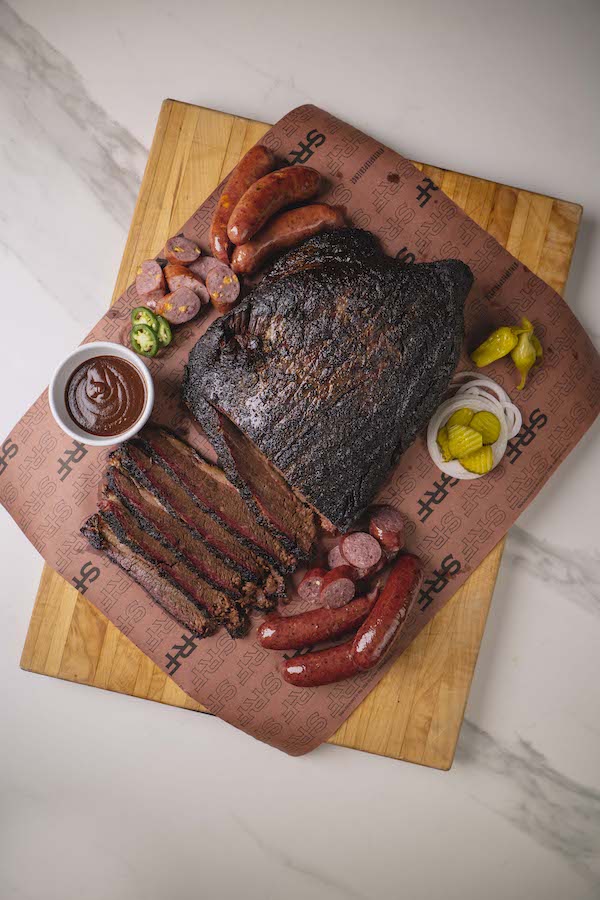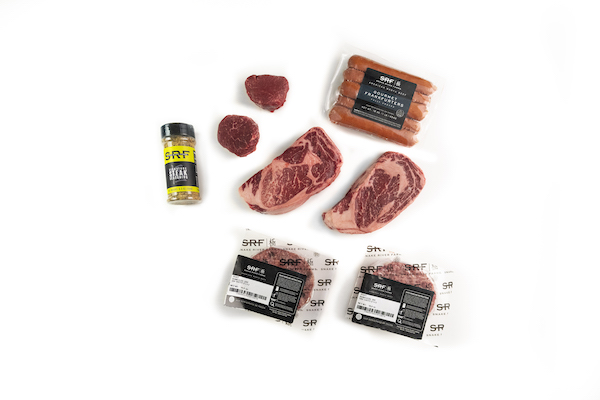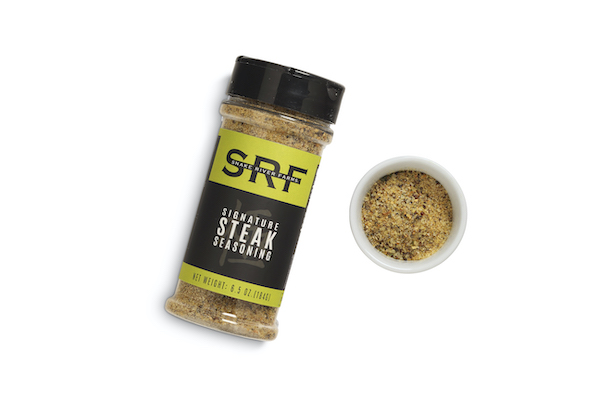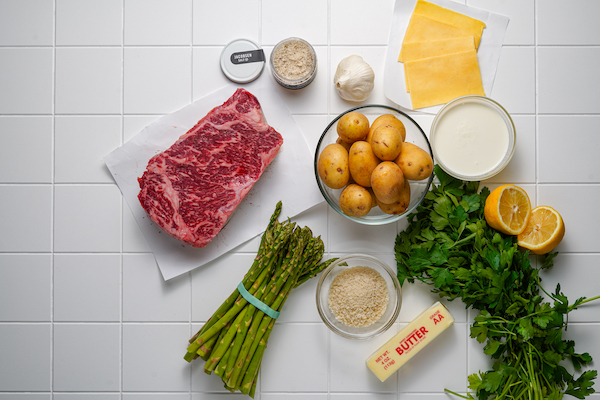Guide: How to cook Prime Rib
HOW TO COOK A PRIME RIB
Have your prime rib and ready to cook?
Here are the simple steps for a beautifully cooked prime rib roast:
- THAW - Set your roast on a tray and place in the refrigerator. A prime rib can take 3 to 4 days to thaw. Not enough time? See Quick Thaw Method.
- HEAT OVEN – Set to 350°F.
- OPEN PACKAGE – Remove prime rib from packaging.
- SEASON – Generously apply kosher salt or your favorite rub, like SRF Rosemary Roast Seasoning. Be sure to cover all sides, including the ends.
- ROAST - Set prime rib in a roasting pan and place in the heated oven. The approximate cook time is 15 to 20 minutes per pound. Temperature is the best way to know exactly when the roast is ready. Leave in oven until the internal temperature of your prime rib corresponds with your preferred finish. Refer to our prime rib temperature chart below for different levels of doneness.
- REST - When your roast reaches the desired temperature, remove it from the oven and place it on a cutting board. Loosely tent with foil and allow to rest 20 to 30 minutes. The internal temperature will rise about 5 degrees and the juices will be reabsorbed.
- SLICE & SERVE – Cut your rested prime rib against the grain and serve.
Check out our prime rib roast temperature guide for preferred doneness:
| Preference | Description | Internal Temp. |
| Rare | Red, cool center | 110° |
| Medium Rare | Red, warm center | 120° |
| Medium | Pink throughout | 130° |
| Medium Well | Pink center | 140° |
Are you a visual learner? See our short video “Prime Rib Tips and Tricks".
OTHER COOKING METHODS
This is the easiest and surefire way to prepare an amazing prime rib. Just follow the steps below. A video with the Simple Prep Method can be viewed here.
Pre-heat oven
Set the oven temperature to 350°F degrees.
Apply seasonings
Season prime rib with salt and pepper. We recommend salt with a larger crystal size such as Jacobsen or Kosher salt. You can also use your favorite rub or paste. No matter what you use, sprinkle the seasonings generously.

Roast in oven
Place roast in a rack, fat side up, over the roasting pan and cook 15- 20 minutes per pound. Only use time as a guideline. A thermometer is your best tool to determine doneness.
Remove from oven
Pull the roast when it is at 110°F for rare, 120°F for medium-rare and 130°F for medium. The temperatures will continue to rise about 10 degrees while resting.
Rest
Let prime rib rest at room temperature for at least 30 minutes.
Slice and serve
Slice against the grain of the meat and serve.
Are you a visual learner? See our short video “Cook the perfect prime rib".
The reverse sear method roasts the prime rib at lower heat for a consistent cook, then uses a sear at the end for a rich, savory crust. It takes a little more technique but is well worth the extra effort.
Pre-heat oven
Set the oven temperature to 275°F degrees.
Apply seasonings
Season prime rib with salt and pepper. We recommend salt with a larger crystal size such as Jacobsen or Kosher salt. You can also use your favorite rub or paste. No matter what you use, sprinkle the seasonings generously.

Roast in oven
Place roast in a rack, fat side up, over the roasting pan and cook for 20-25 minutes per pound. Only use times as a guideline. A thermometer should be used to determine doneness.

Remove from oven
Pull the roast when it is at 110°F degrees for rare, 120°F degrees for medium rare and 130°F degrees for medium. The temperatures will continue to rise about 10 degrees while resting.

Rest
Rest prime rib for at least 30 minutes. With five minutes remaining, turn your oven on broil.

Sear
Place the roast back in the oven and rotate it every 90 seconds until all sides have been exposed to the high heat. The idea is to create a golden brown crust that adds flavor and an intoxicating bite to each slice.

Slice and serve
Slice against the grain of the meat and serve.


TWO-STEP METHOD
We recommend using the two-step skillet-to-oven method, also referred to as “steakhouse style” to prepare petite roasts that are approximately 2 lbs or less. This method uses a quick skillet sear and the roast is placed in the oven to finish cooking. This method is great for tenderloin and Manhattan roasts.
PRE-HEAT
Set the oven temperature to 350°F degrees. Heat a heavy skillet over medium high heat until hot. Add a light coat of vegetable oil to the skillet.
SEASON
Season roast with salt and pepper. We recommend salt with a larger crystal size such as Jacobsen sea salt or Kosher salt. You can also use your favorite rub. No matter what you use, sprinkle the seasonings generously.
SEAR
Place roast in hot skillet to sear. Turn roast to get an even brown crust on all sides (about 2 minutes per side).
COOK
Place skillet and roast in a 350°F degree oven for 25 to 50 minutes depending on desired doneness. Turn once halfway through the cooking time.
REMOVE FROM OVEN
Pull the roast when it is at 110°F degrees for rare, 120°F degrees for medium rare and 130°F degrees for medium. The temperatures will continue to rise about 10 degrees while resting.
Only use times as a guideline. A thermometer should be used to determine doneness.
COOKING TIME GUIDELINES
WEIGHT | MEDIUM RARE | MEDIUM | |
|---|---|---|---|
About 1.5 lbs | 27 to 34 min. | 35 to 42 min. | |
About 2 lbs | 40 to 49 min. | 49 to 59 min. |
REST
Loosely tent with foil and let rest 10 to 15 minutes.
SLICE AND SERVE
Slice against the grain of the meat and serve.

PRIME RIB BASICS

what is a prime rib?
Prime rib, otherwise known as a standing rib roast, is a cut of beef that comes for the primal rib section of the cow. This is the same area ribeye steak is cut from. A simple way to understand prime rib is that it’s basically ribeye before it’s cut up. Instead of individual steaks, prime rib is cooked whole as a roast, producing a different and sought after flavor experience compared to ribeye.
“Prime” rib has become such a colloquial term that many assume these rib roasts are all prime USDA grade. But that is not always the case, which is why the USDA grade and quality of fat marbling should play a role in how you pick out a prime rib roast at the store.
HOW TO PICK A PRIME RIB ROAST
When you shop for a prime rib roast, look for a roast with a high level of marbling – the fat contained within the muscles of the meat. As a roast heats in the oven, the intramuscular fat will melt and provide more flavor and a tender, juicy texture.
While choosing the ideal prime rib for your special dinner is a matter of personal preference, the level of marbling is a key measurement of the quality of a roast. The top two levels of marbling on the USDA grading scale are Choice and Prime. Only about 4 to 5% of all beef graded by the USDA scale achieve this level.
All Snake River Farms American Wagyu prime ribs and roasts exceed the marbling amount found in USDA Prime. Black grade is our American Wagyu marbling standard. Roasts in this category are high in marbling and will provide a memorable dining experience. The most marbled roasts available from Snake River Farms are Gold Grade. These are the ultimate prime ribs and roasts due to the intense marbling.

BONE IN VS BONELESS PRIME RIB?
Boneless prime ribs are full of flavor and are easy to slice and serve, while the biggest benefit to bone-in roasts is the impressive appearance they provide. There's something spectacular about setting a bone-in prime rib on your dining room table.
Many home cooks consider a bone-in roast the height of tradition. Some folks believe a bone-in roast provides added flavor. Myth-busting experts like Kenji Lopez-Alt of Serious Eats have conducted extensive taste tests and found boneless and bone-in roasts have a similar flavor profile
However, bone-in roasts do have real benefits. The bone insulates the meat from the oven’s heat which allows the meat surrounding the bone to cook slower, leaving those sections extra juicy and tender.
To make bone-in roasts easy to slice, we recommend cutting the bone from the roast and tying the rib section back to the roast with butcher's twine. When the roast is ready, place the rib bones back in the oven for 20 minutes. Cut the rack into individual ribs and place them on the serving tray as a special treat.
Learn more about bone-in vs boneless beef.
HOW MUCH PRIME RIB PER PERSON?
Eight ounces of cooked prime rib roast per person is a good serving size. If your table includes more robust appetites or if you want to plan for leftovers, add extra servings to your calculations. Boneless roasts will shrink about 20% and bone-in roasts lose about 30% of the final weight (because of the extra weight of the rib bones).
Refer to the below chart for serving sizes of different types of beef roasts:
| Roast Type | Servings (8 oz.) | Approx. Cook Time |
| Whole Tenderloin | 5-9 Servings | 1.5 - 2 Hours |
| Prime Rib/Ribeye Roast | 10-12 Servings | 2 - 2.75 Hours |
| Striploin | 12-15 Servings | 1.75 - 2.5 Hours |
| Eye of Ribeye | 8-10 Servings | 2 - 2.5 Hours |
| 1/2 Tenderloin | 3-4 Servings | 25 - 30 Minutes |
| Coulotte Steak | 3-4 Servings | 25 - 35 Minutes |
| Tri-Tip | 5-7 Servings | 25 - 35 Minutes |
| Manhattan | 5-7 Servings | 30- 40 |

PREPARATION TIPS
Now that you’ve got an understanding of how to cook a delicious prime rib roast, the experts at Snake River Farm are here to give some quick tips on preparing your prime rib.
HOW LONG TO DEFROST PRIME RIB
All Snake River Farms roasts ship frozen to maintain optimal quality. Before cooking your roast, we recommend completely thawing it in the refrigerator. A completely frozen roast can take several days to thaw, so plan ahead.
If time is a factor, it’s possible to “speed thaw” by placing the sealed roast in cool water to accelerate the process.
BRING TO ROOM TEMPERATURE
Remove the prime rib from the fridge two hours before it is scheduled to go in the oven. Allow it to come to room temperature. This will help the roast cook evenly.
WHEN TO SALT YOUR PRIME RIB
A tip used by many restaurants is to liberally apply kosher salt to the roast on all sides the night before you plan to cook it. Leave it uncovered in your fridge overnight. The roast may appear dried out, but it will actually increase the moisture in the prime rib when finished. The dry exterior produces an outside crust that adds texture and flavor.
OUR FAVORITE PRIME RIB RECIPES
Prime rib makes for an excellent center piece for any special occassion, especially large family gatherings, holiday dinners, and other celebrations.
Here are a few of our favorite prime rib recipes:
PRIME RIB LEFTOVERS
Leftover cooked Prime Rib, thinly sliced and layered on a butter-toasted roll with creamy horseradish and au jus for dipping is the perfect recipe. > LEARN MORE

